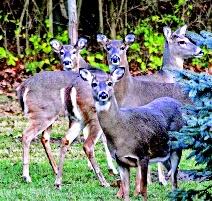
3 minute read
Our deer ones
deerones our

Advertisement


The land we live on originally belonged to the White-Tailed Deer’s ancestors. There is a tree line down the back of the property that they have followed for years. They will always find safe passage on our five acres as long as we own it. Many of our neighbors feel this same way.
We know they will be hunted from time to time when they move out of the safe zone in their several mile home territory, but they were the original homesteaders here and we respect that. We enjoy the privilege of watching them and admiring their beauty as they move through the trees.

DEER FACTS
White Tails have adapted to many habitats as they have lost their original woods over the past few decades. Many males often range from 150 to 250 pounds. Females usually weigh in at 80 to 200. It takes a deer almost two years to fully mature. Ironically, the average life span is just two to three years.
Most White Tails are reddish-brown in color during the summer and a greyish-brown during the winter. Males begin to grow antlers as yearlings and shed these each year. It’s an old deer tale that you can always tell their age by the number of antler branches. Apparently, the number of branches produced each year varies per deer. Males who have the start of antlers but without branches are called “spike” bucks. One in every 10,000 female deer also produce antlers.
Deer mate in late fall or winter and the young are born in late spring. It is fun to watch the wobbly, young spotted baby deer come out with their moms for the first time. Mothers can leave their young for short times to feed themselves the first two weeks because the babies have no scent that predators can smell to find them easily.



PROLIFIC POPULATION
The White-tailed Deer is the state animal in Illinois and several other states. Deer populations have grown significantly and exceed normal limits in many Illinois counties. Natural predators (cougars and wolves in particular) are no longer found in significant numbers in many habitats. Viral diseases like Chronic Wasting and Blue Tongue have weakened the deer population the last few years.
While hunting season helps cull the population down, it is still not enough to bring it into normal range in many areas. Trees and plants are often destroyed by hungry deer since they are herbivores. Auto collisions with deer happen frequently as the deer population rises.
There are no easy answers as man and deer habitats come closer together. These beautiful mammals co-existed with man a hundred years ago. That’s when deer population numbers were kept in balance by both humans and other wildlife predators. What will the next 100 years look like?
FALL INLOVE WITHANEW HOME





KIRSTENSCHROEDER 309•824•1001
PROVENRESULTS • FABLEDSERVICE •HERE&HAPPYTOHELPYOU! LET’STALK! CALLMETODAYTOBEPROPERLYREPRESENTEDTOBUYYOURNEXTHOME! November 2020 | Limited Magazine 25




